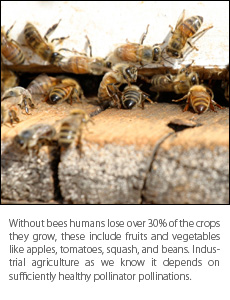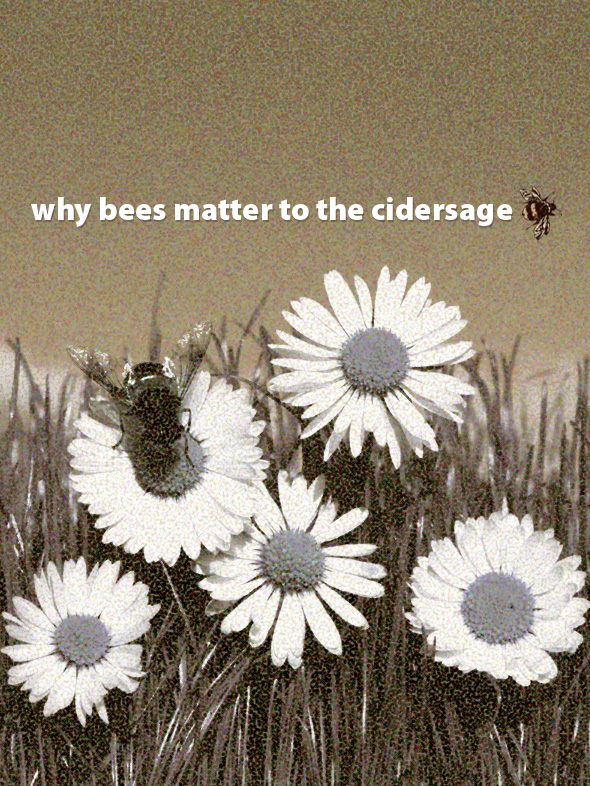Cidersage
Hard Cider, Mead, and Miscellany from the Front Range of Colorado
Bee Die-Off
The Work (and Death) of Bees
Amy Lewis
Doctoral candidate & instructor of political science and agricultural policy Colorado State University
“I like pulling on a baggy bee suit, forgetting myself and getting as close to the bees’ lives as they will let me, remembering in the process that there is more to life than the merely human.” ― Sue Hubbell, A Book of Bees: And How to Keep Them
On The Cidersage Blog, cider and mead tend to be discussed in isolation, with an emphasis on the immediate qualities of the drink at hand and with a nod in the direction of the human agency that brought that product to the bottle. The present draught, its aromas and flavors, is the fetish of our attention as we measure its value against the yardstick of our preferences. What is unspoken, if not forgotten altogether, is that every sip of cider or mead is the culmination of an ancient transaction, older even than the relationship between brewer and yeast, farmer and soil. I refer, of course, to the interaction between animal and flower, for every glass of mead and cider owes its existence only in a secondary sense to man. First and foremost, it is a product of the bees.
 Everyone knows that bees make honey and beeswax, luxury goods of a bygone era that, like the Silk Road, lost their import in the light of new innovations, in this case industrial sugar cane production and electricity. Thus, bees are commonly recognized as necessary for mead. Less understood is that they are just as necessary for cider. Why, you ask? The answer lies in the most important service bees provide mankind. Though honey and beeswax are no longer as sought after as they once were, pollination is as important as ever, if not more so. In the next four decades, the global population is expected to reach 10 billion and agricultural yields, so dependent on expensive nonrenewable inputs like fertilizers synthesized with fossil fuels, will be expected, as always, to meet the pressure of a growing population.
Everyone knows that bees make honey and beeswax, luxury goods of a bygone era that, like the Silk Road, lost their import in the light of new innovations, in this case industrial sugar cane production and electricity. Thus, bees are commonly recognized as necessary for mead. Less understood is that they are just as necessary for cider. Why, you ask? The answer lies in the most important service bees provide mankind. Though honey and beeswax are no longer as sought after as they once were, pollination is as important as ever, if not more so. In the next four decades, the global population is expected to reach 10 billion and agricultural yields, so dependent on expensive nonrenewable inputs like fertilizers synthesized with fossil fuels, will be expected, as always, to meet the pressure of a growing population.
Without bee pollination, which improves the yields of all cropsi, is necessary for over 30% of them (e.g. apples)ii, and unlike synthetic fertilizers is a renewable input that in healthy agricultural systems is provided free of charge by Mother Nature, the industrial agriculture system as we know it fails. Sure, there are still some plants, the cereal grains like corn and wheat, which are primarily pollinated by wind and are versatile enough to provide the caloric needs of a large human population. Nevertheless, these are not enough to provide the diversity and nutrition humans require. Individuals fed on nothing but meat and grain grow overweight and lethargiciii. Without the flavors and vitamins present in pollination-dependent fruits like tomatoes, apples, blackberries, almonds, squash, and many, many more, the human diet suffers so much so it is unlikely good nutrition would be available to the vast majority of the population.
And of course, such a world would have no cider or mead.
 As a doctoral candidate in agricultural policy specializing in renewable inputs like pollination, I know that the likelihood of the above scenario happening in our lifetimes – a world without bees and without the insect population necessary to support industrial agriculture – has been increasing in probability each year since 2007 when bee population all over the industrialized world began to collapse. Although there continues to be a significant amount of misinformation propagated by certain chemical industry groups supported by Bayer CropScience, Monsanto, and Sygenta, along with their myopic lackeys in the business community (I’m looking at you, Jon Entine of Forbes Magazine), a scientific consensus has emerged about the causes of this collapseiv. The evidence supports two primary factors – a loss of wildflower/meadow habitat causing bee populations to starve when a regional crop specialty is not in bloomv and a new category of pesticides known as neonicotinoids (or neonics) which harms pollinators’ central nervous systems and accretes in the hive overtime, destroying bee brood and devastating hive healthvi.
As a doctoral candidate in agricultural policy specializing in renewable inputs like pollination, I know that the likelihood of the above scenario happening in our lifetimes – a world without bees and without the insect population necessary to support industrial agriculture – has been increasing in probability each year since 2007 when bee population all over the industrialized world began to collapse. Although there continues to be a significant amount of misinformation propagated by certain chemical industry groups supported by Bayer CropScience, Monsanto, and Sygenta, along with their myopic lackeys in the business community (I’m looking at you, Jon Entine of Forbes Magazine), a scientific consensus has emerged about the causes of this collapseiv. The evidence supports two primary factors – a loss of wildflower/meadow habitat causing bee populations to starve when a regional crop specialty is not in bloomv and a new category of pesticides known as neonicotinoids (or neonics) which harms pollinators’ central nervous systems and accretes in the hive overtime, destroying bee brood and devastating hive healthvi. 
Although chemical industry and business leaders have rallied in defense of neonics, claiming that they are safer for human health than conventional pesticides (although not a single long-term study of neonics on the human central nervous system has been conducted to justify that claim), nothing could be worse for long-term business and agricultural interests than the destruction of the species that provides a vital and free agricultural input in an era when so many other inputs necessary to maintain industrial agricultural yields – irrigation from depleting aquifers, fossil fuel synthesized fertilizer, gasoline powered farm equipment – have become so finite and expensivevii. The wise investor would be considering ways in which to support bees and maintain pollination, even if the returns are only witnessed in the bounty of the provender available for a well-prepared meal and the crisp pleasure of a glass of cider.
When we drink mead and cider, just as when we consume any other product, we do not drink in a time and place isolated from larger issues. Not only does each sip connect us to the present world of social possibility, from the companions who we share our drink with to the regional and global agricultural system that has brought the drink to our table, but we are also connected to the past, both our ancestors, who have enjoyed the products of fermentation for at least five thousand years, and our nonhuman neighbors, the bees who have, through pollination, made our enjoyment of cider and mead possible.
It is my hope that armed with this information you will take the next opportunity to raise your glass in honor and recognition of the bees. Additionally, you might consider taking other actions to “invest” and support this most necessary of renewable agricultural inputs by doing one of the following:
- Contact the North American Pesticide Action Network or the Natural Resource Defense Council to see how you can help raise awareness about the danger neonics represent to our agricultural system.
- Write to the EPA to request that they suspend use of neonics in North America (Europe banned them in the spring of 2013 following several bans already in place in Germany, France, and Italy)viii, but a loophole in the regulation of pesticides in North Americaix as well as an understaffed agency that outsources its studies on chemical safety to the companies producing the chemicals has inhibited effective regulation on the use of neonics in the US market.
- Support the maintenance of bee habitat (meadow spaces) in your community.
- Grow wildflowers that bloom for 4-6 months out of the year on your porch or in your garden.
References
Copyright © 2024 | MH Corporate basic by MH Themes

Leave a comment